#state theatre sydney
Explore tagged Tumblr posts
Text
lotronstage on Instagram, 16 December 2024:
Meet the talent and creativity behind the magical world of Middle-earth live, onstage. Some of our Australian cast tell us about the skills needed to transform into their characters as they try on their costumes, wigs, hair and make-up for the first time.
#lotr musical#lord of the rings musical#state theatre sydney#australian tour#interview#rarmian newton#terence crawford#jemma rix#wern mak#laurence boxhall#video
37 notes
·
View notes
Text
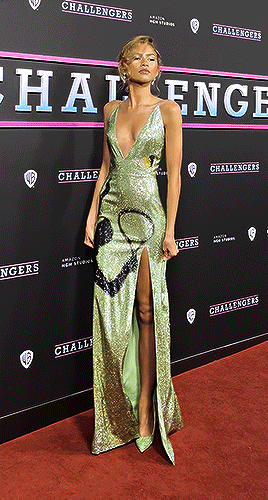


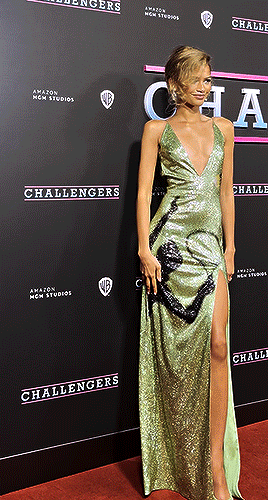
ZENDAYA Attends the Australian premiere of "Challengers" at the State Theatre on March 26, 2024 in Sydney, Australia.
#zendaya#zendayaedit#challengers#flawlessbeautyqueens#thequeensofbeauty#flashing gif#usersugar#byaurore#tuserrachel#userallisyn#tuserpris#nessa007#useraashna#userrlaura#jemmablossom#alivedean#useriselin#userines#userquel#userreh#tuserhan#tusertha#tusercora#tuserpolly#userzil#userzo#usereena#userelio#tusersadie#userladiesblr
2K notes
·
View notes
Text
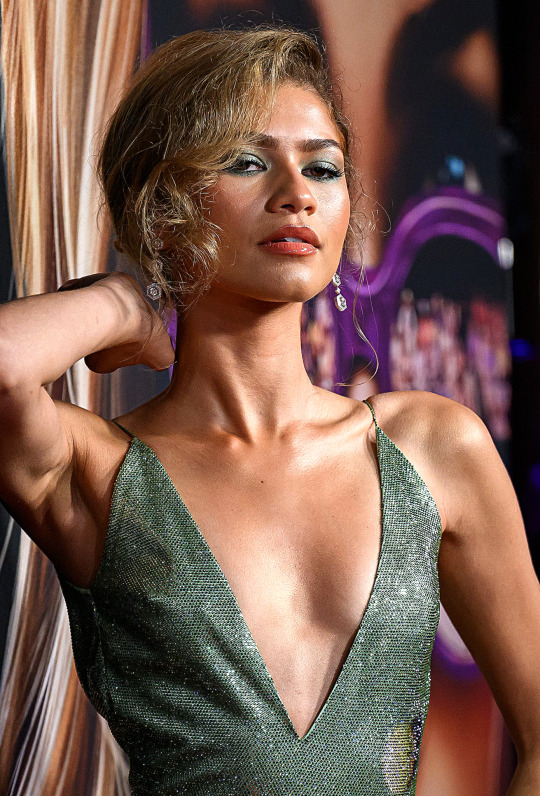
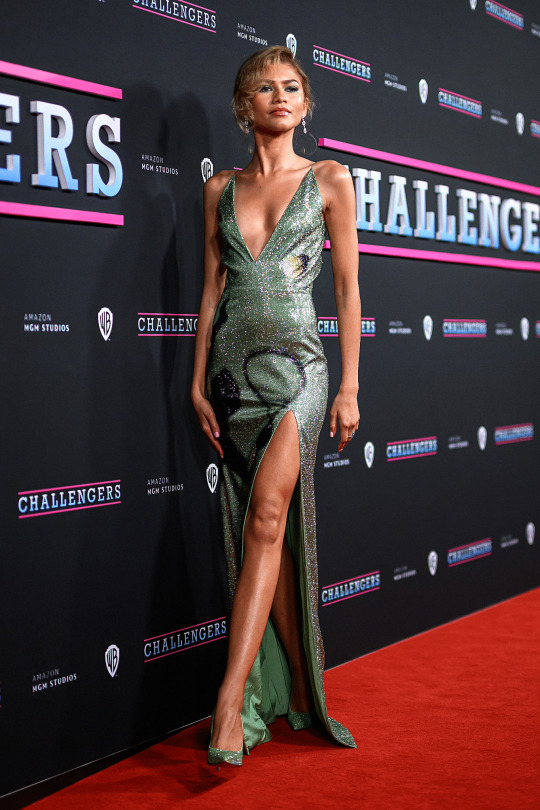
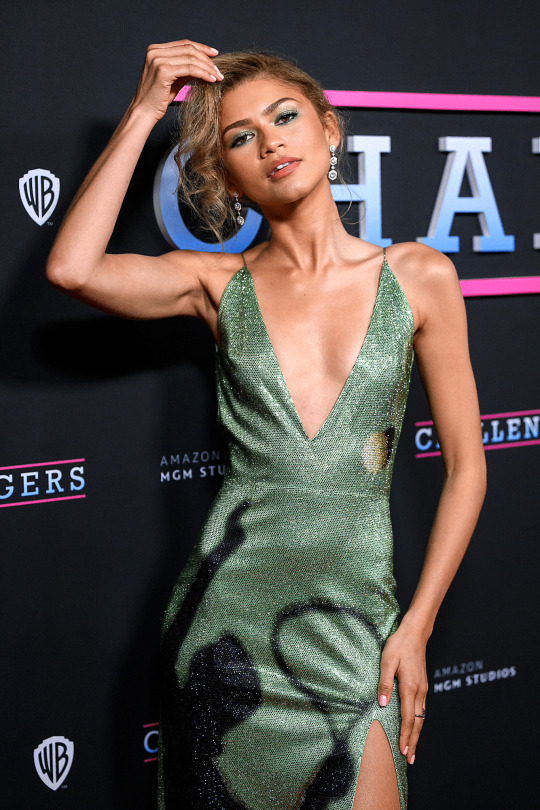

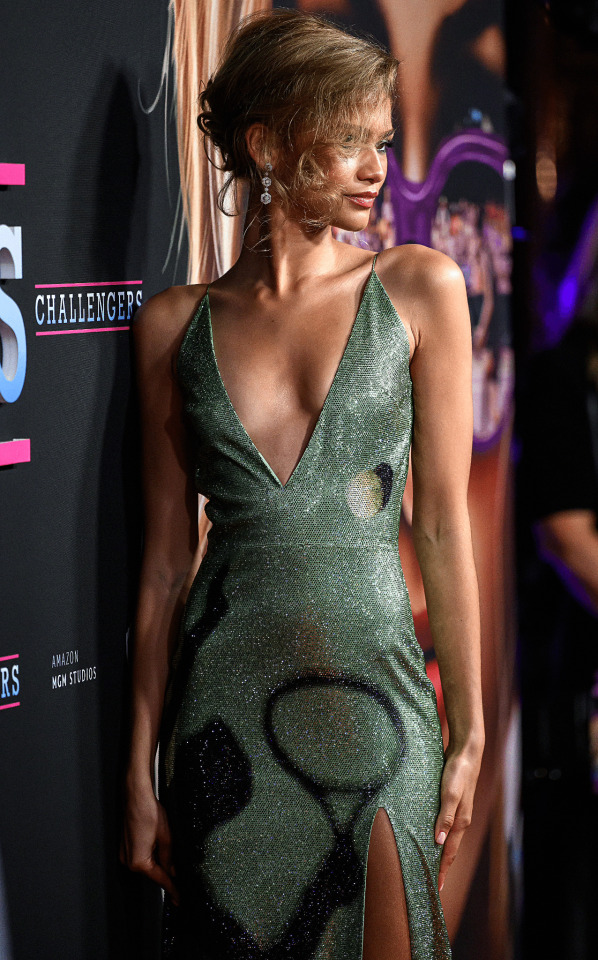
Zendaya attends the Australian premiere of "Challengers" at the State Theatre on March 26, 2024 in Sydney, Australia.
#zendaya#thequeensofbeauty#breathtakingqueens#flawlessbeautyqueens#femalestunning#femalesource#glamoroussource#wonderfulwomendaily#cinemapix#nessa007#userladiesblr#userladiesofcinema#marvelladiesdaily#marvelladiesedit#dailyavengers#zendayaedit#zendayasource#challengers#premiere challengers
767 notes
·
View notes
Text

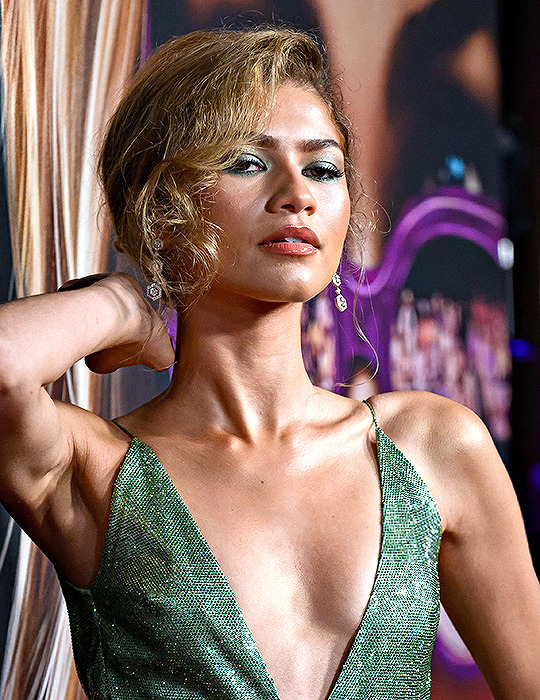
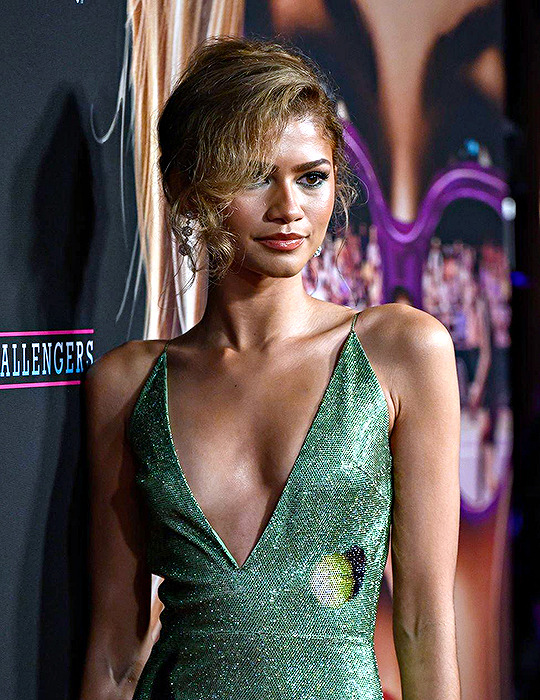
ZENDAYA Attends the Australian premiere of "Challengers" at the State Theatre on March 26, 2024 in Sydney, Australia.
#zendaya#zendayaedit#byaurore#usersugar#userbbelcher#tuserrachel#userallisyn#tuserpris#edit#event#nessa007#*#by aurore#usersavana#tusersadie#challengers#userelio#usereena#userkam#userrlaura#userreh#userquel
730 notes
·
View notes
Text
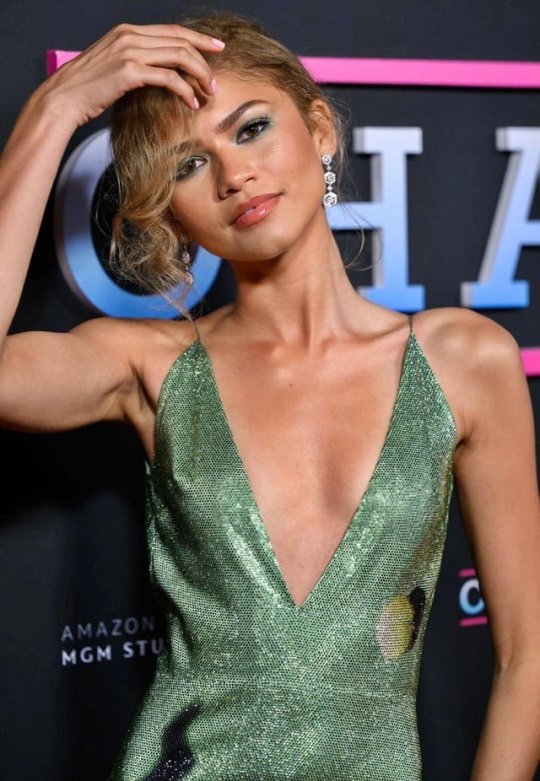
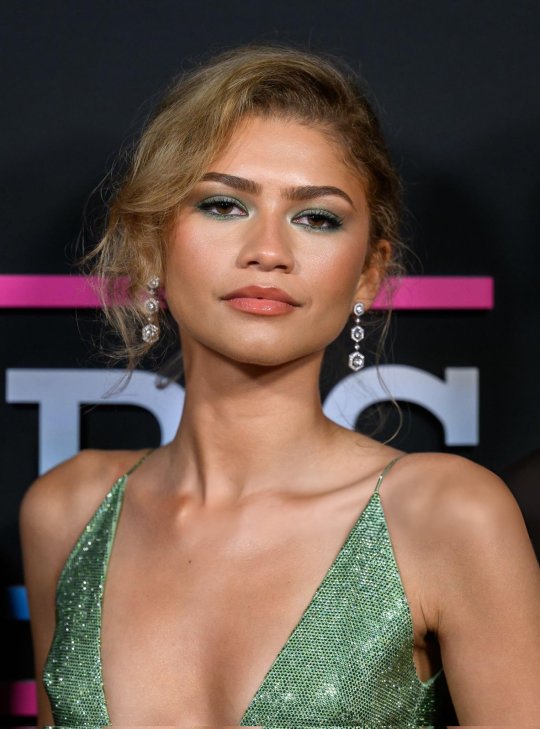
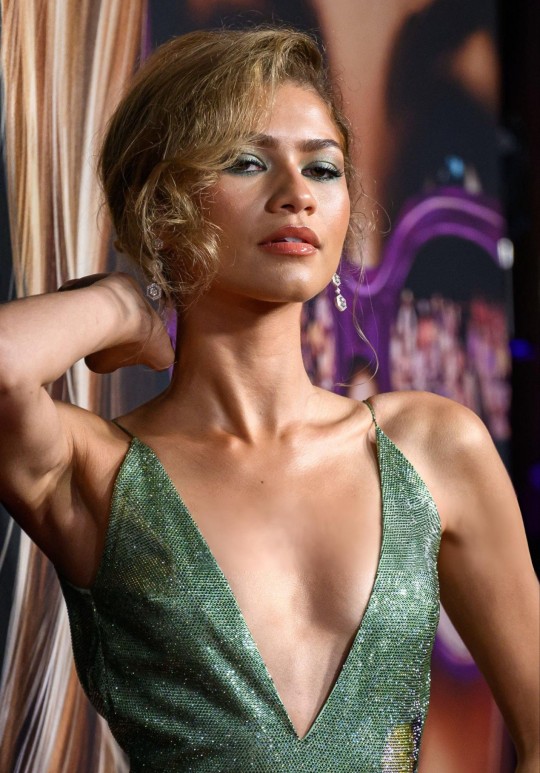
Zendaya attends the Australian premiere of "Challengers" at the State Theatre on March 26, 2024 in Sydney, Australia.
#zendaya coleman#zendaya#movie premiere#challengers#sydney australia#march 2024#stunning#hot celebs#celebs#actress#celebrities
68 notes
·
View notes
Text



THE JOURNEY THROUGH OZ TOUR:
The first WICKED red carpet premiere will take place in SYDNEY, Australia in exactly 2 weeks on November 3rd. The Sydney State Theatre will be transformed into Munchkinland for the event.

The LOS ANGELES premiere will take place in the Dorothy Chandler Pavilion on November 9th. The venue will be transformed into Shiz University.

The MEXICO CITY premiere will take place in the National Auditorium on November 11th. It will be transformed into the enchanted forest.

The NEW YORK premiere will take place in the Museum of Modern Art on November 14th. It will be transformed into the Ozdust Ballroom.

The LONDON premiere will take place in the Royal Festival Hall on November 18th and it will be transformed into The Emerald City.

#wicked#wicked movie#ariana grande#glinda upland#elphaba thropp#gelphie#dailygrande#cynthia erivo#galinda upland#wicked the musical#jeff goldblum#jon m chu#jonathan bailey#ethan slater#marissa bode#bowen yang#michelle yeoh
23 notes
·
View notes
Photo






MARGOT ROBBIE attending Australian Premiere of ‘Babylon’ at State Theatre in Sydney, Australia (January 16, 2023)
#margot robbie#by beck#edits#mrobbieedit#babylon 2022#femaledaily#dwomenedit#ladiesofcinema#tusersadie#usermandie#usersavana#userquel#tusercourtney#useraurore#blondesource#glamoroussource#flawlessbeautyqueens#events#other#ours
603 notes
·
View notes
Photo




MARGOT ROBBIE at the Babylon premiere at State Theatre in Sydney, Australia (January 16, 2023)
#margot robbie#mrobbieedit#edits#useralessia#userrobin#glamoroussource#wonderfulwomendaily#tusertha#ryancoogler#userfrodosam#femalestunning#usermandie#flawlessbeautyqueens#thequeensofbeauty#usermorgan#tusermary#userlau#usersameera
948 notes
·
View notes
Text
(Mostly) Lost, but Not Forgotten: Omar Khayyam (1923) / A Lover’s Oath (1925)

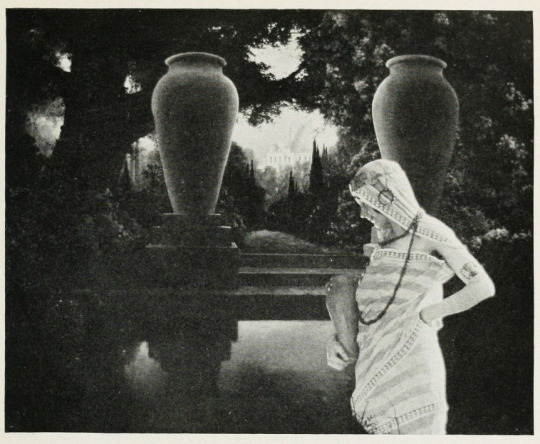
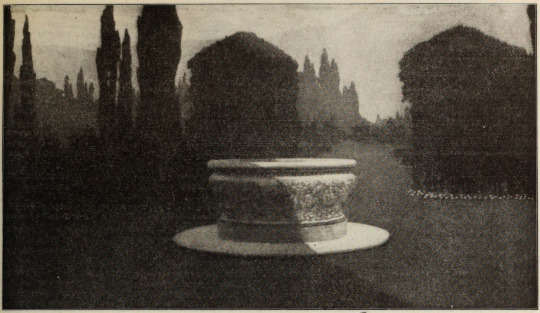
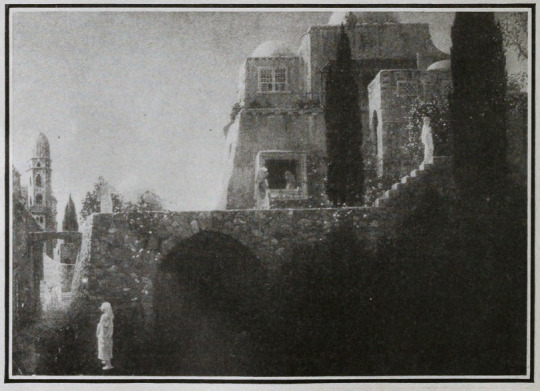
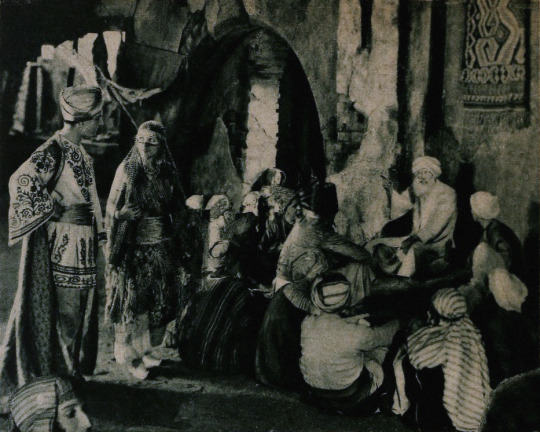


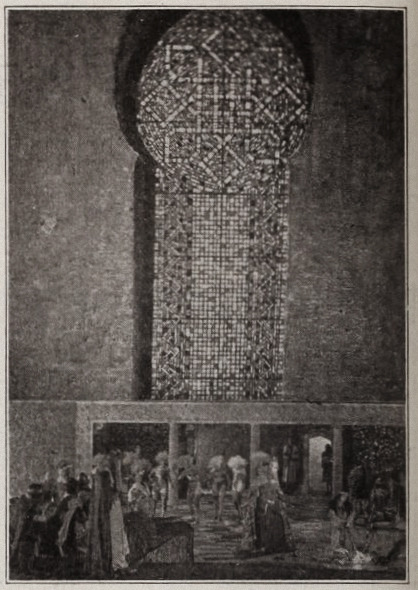
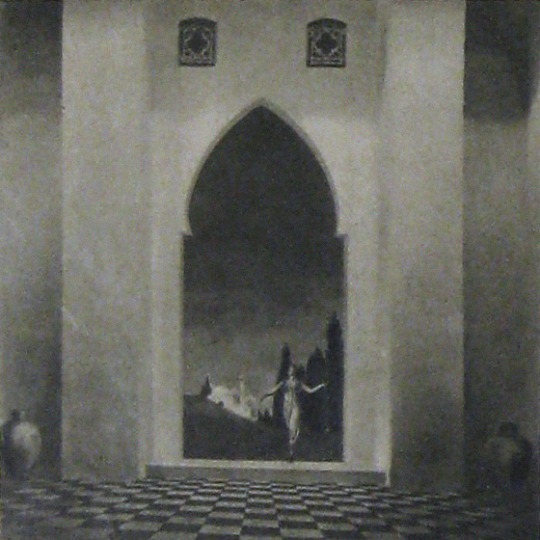
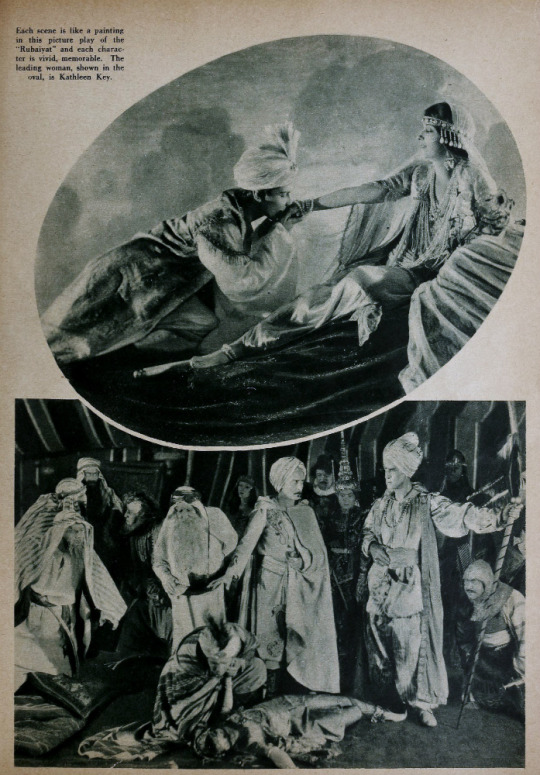
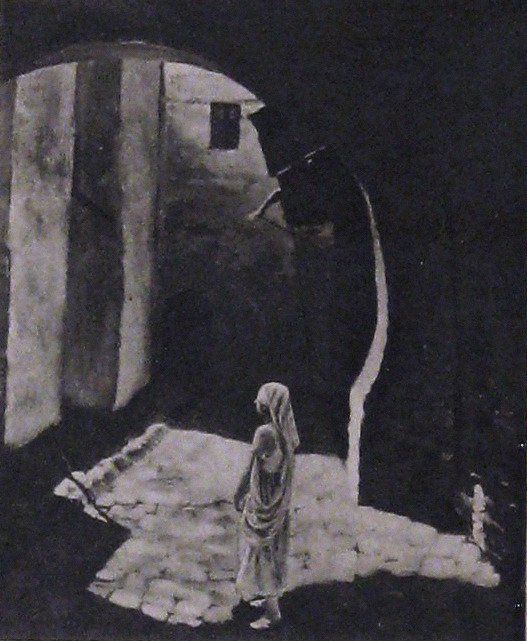

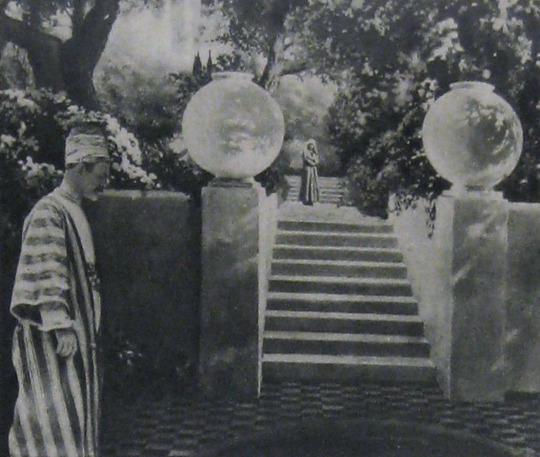
Alternate Titles: The Rubaiyat of Omar Khayyam, The Rubaiyat, Omar Khayyam, Omar
Direction: Ferdinand Pinney Earle; assisted by Walter Mayo
Scenario: Ferdinand P. Earle
Titles: Marion Ainslee, Ferdinand P. Earle (Omar), Louis Weadock (A Lover’s Oath)
Inspired by: The Rubaiyat of Omar Khayyam, as edited & translated by Edward FitzGerald
Production Manager: Winthrop Kelly
Camera: Georges Benoit
Still Photography: Edward S. Curtis
Special Photographic Effects: Ferdinand P. Earle, Gordon Bishop Pollock
Composer: Charles Wakefield Cadman
Editors: Arthur D. Ripley (The Rubaiyat of Omar Khayyam version), Ethel Davey & Ferdinand P. Earle (Omar / Omar Khayyam, the Director’s cut of 1922), Milton Sills (A Lover’s Oath)
Scenic Artists: Frank E. Berier, Xavier Muchado, Anthony Vecchio, Paul Detlefsen, Flora Smith, Jean Little Cyr, Robert Sterner, Ralph Willis
Character Designer: Louis Hels
Choreography: Ramon Novarro (credited as Ramon Samaniegos)
Technical Advisors: Prince Raphael Emmanuel, Reverend Allan Moore, Captain Dudley S. Corlette, & Captain Montlock or Mortlock
Studio: Ferdinand P. Earle Productions / The Rubaiyat, Inc. (Production) & Eastern Film Corporation (Distribution, Omar), Astor Distribution Corporation [States Rights market] (Distribution, A Lover’s Oath)
Performers: Frederick Warde, Edwin Stevens, Hedwiga Reicher, Mariska Aldrich, Paul Weigel, Robert Anderson, Arthur Carewe, Jesse Weldon, Snitz Edwards, Warren Rogers, Ramon Novarro (originally credited as Ramon Samaniegos), Big Jim Marcus, Kathleen Key, Charles A. Post, Phillippe de Lacy, Ferdinand Pinney Earle
Premiere(s): Omar cut: April 1922 The Ambassador Theatre, New York, NY (Preview Screening), 12 October 1923, Loew’s New York, New York, NY (Preview Screening), 2 February 1923, Hoyt’s Theatre, Sydney, Australia (Initial Release)
Status: Presumed lost, save for one 30 second fragment preserved by the Academy Film Archive, and a 2.5 minute fragment preserved by a private collector (Old Films & Stuff)
Length: Omar Khayyam: 8 reels , 76 minutes; A Lover’s Oath: 6 reels, 5,845 feet (though once listed with a runtime of 76 minutes, which doesn’t line up with the stated length of this cut)
Synopsis (synthesized from magazine summaries of the plot):
Omar Khayyam:
Set in 12th century Persia, the story begins with a preface in the youth of Omar Khayyam (Warde). Omar and his friends, Nizam (Weigel) and Hassan (Stevens), make a pact that whichever one of them becomes a success in life first will help out the others. In adulthood, Nizam has become a potentate and has given Omar a position so that he may continue his studies in mathematics and astronomy. Hassan, however, has grown into quite the villain. When he is expelled from the kingdom, he plots to kidnap Shireen (Key), the sheik’s daughter. Shireen is in love with Ali (Novarro). In the end it’s Hassan’s wife (Reicher) who slays the villain then kills herself.
A Lover’s Oath:
The daughter of a sheik, Shireen (Key), is in love with Ali (Novarro), the son of the ruler of a neighboring kingdom. Hassan covets Shireen and plots to kidnap her. Hassan is foiled by his wife. [The Sills’ edit places Ali and Shireen as protagonists, but there was little to no re-shooting done (absolutely none with Key or Novarro). So, most critics note how odd it is that all Ali does in the film is pitch woo, and does not save Shireen himself. This obviously wouldn’t have been an issue in the earlier cut, where Ali is a supporting character, often not even named in summaries and news items. Additional note: Post’s credit changes from “Vizier” to “Commander of the Faithful”]
Additional sequence(s) featured in the film (but I’m not sure where they fit in the continuity):
Celestial sequences featuring stars and planets moving through the cosmos
Angels spinning in a cyclone up to the heavens
A Potters’ shop sequence (relevant to a specific section of the poems)
Harem dance sequence choreographed by Novarro
Locations: palace gardens, street and marketplace scenes, ancient ruins
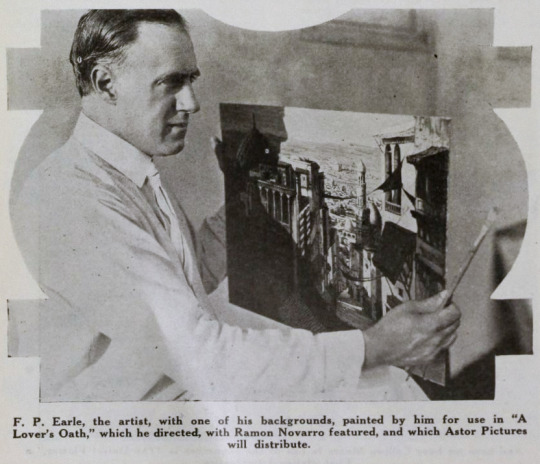
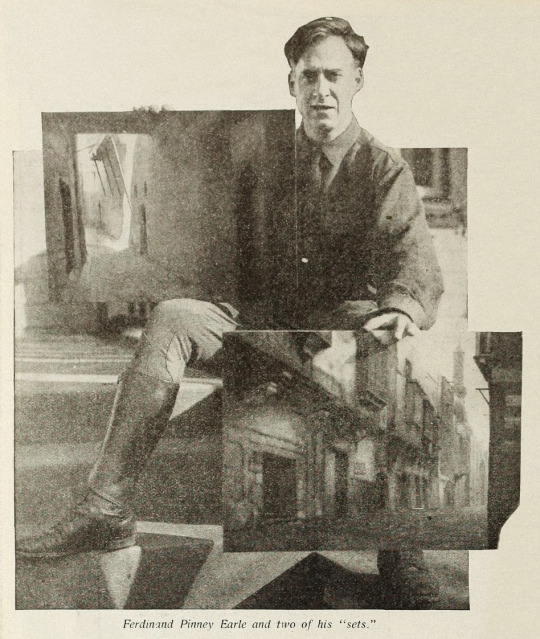
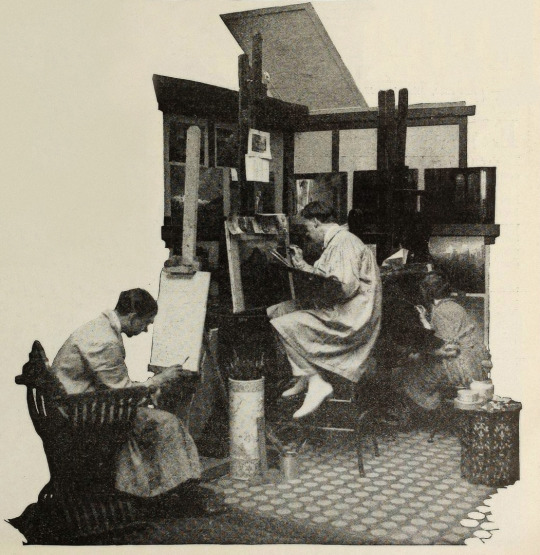


Points of Interest:
“The screen has been described as the last word in realism, but why confine it there? It can also be the last word in imaginative expression.”
Ferdinand P. Earle as quoted in Exhibitors Trade Review, 4 March 1922
The Rubaiyat of Omar Khayyam was a massive best seller. Ferdinand Pinney Earle was a classically trained artist who studied under William-Adolphe Bougueraeu and James McNeill Whistler in his youth. He also had years of experience creating art backgrounds, matte paintings, and art titles for films. Charles Wakefield Cadman was an accomplished composer of songs, operas, and operettas. Georges Benoit and Gordon Pollock were experienced photographic technicians. Edward S. Curtis was a widely renowned still photographer. Ramon Novarro was a name nobody knew yet—but they would soon enough.
When Earle chose The Rubaiyat as the source material for his directorial debut and collected such skilled collaborators, it seemed likely that the resulting film would be a landmark in the art of American cinema. Quite a few people who saw Earle’s Rubaiyat truly thought it would be:
William E. Wing writing for Camera, 9 September 1922, wrote:
“Mr. Earle…came from the world of brush and canvass, to spread his art upon the greater screen. He created a new Rubaiyat with such spiritual colors, that they swayed.” … “It has been my fortune to see some of the most wonderful sets that this Old Earth possesses, but I may truly say that none seized me more suddenly, or broke with greater, sudden inspiration upon the view and the brain, than some of Ferdinand Earle’s backgrounds, in his Rubaiyat. “His vision and inspired art seem to promise something bigger and better for the future screen.”
As quoted in an ad in Film Year Book, 1923:
“Ferdinand Earle has set a new standard of production to live up to.”
Rex Ingram
“Fifty years ahead of the time.”
Marshall Neilan
The film was also listed among Fritz Lang’s Siegfried, Chaplin’s Gold Rush, Fairbanks’ Don Q, Lon Chaney’s Phantom of the Opera and The Unholy Three, and Erich Von Stroheim’s Merry Widow by the National Board of Review as an exceptional film of 1925.
So why don’t we all know about this film? (Spoiler: it’s not just because it’s lost!)
The short answer is that multiple dubious legal challenges arose that prevented Omar’s general release in the US. The long answer follows BELOW THE JUMP!
Earle began the project in earnest in 1919. Committing The Rubaiyat to film was an ambitious undertaking for a first-time director and Earle was striking out at a time when the American film industry was developing an inferiority complex about the level of artistry in their creative output. Earle was one of a number of artists in the film colony who were going independent of the emergent studio system for greater protections of their creative freedoms.
In their adaptation of The Rubaiyat of Omar Khayyam, Earle and Co. hoped to develop new and perfect existing techniques for incorporating live-action performers with paintings and expand the idea of what could be accomplished with photographic effects in filmmaking. The Rubaiyat was an inspired choice. It’s not a narrative, but a collection of poetry. This gave Earle the opportunity to intersperse fantastical, poetic sequences throughout a story set in the lifetime of Omar Khayyam, the credited writer of the poems. In addition to the fantastic, Earle’s team would recreate 12th century Persia for the screen.
Earle was convinced that if his methods were perfected, it wouldn’t matter when or where a scene was set, it would not just be possible but practical to put on film. For The Rubaiyat, the majority of shooting was done against black velvet and various matte photography and multiple exposure techniques were employed to bring a setting 800+ years in the past and 1000s of miles removed to life before a camera in a cottage in Los Angeles.
Note: If you’d like to learn a bit more about how these effects were executed at the time, see the first installment of How’d They Do That.
Unfortunately, the few surviving minutes don’t feature much of this special photography, but what does survive looks exquisite:
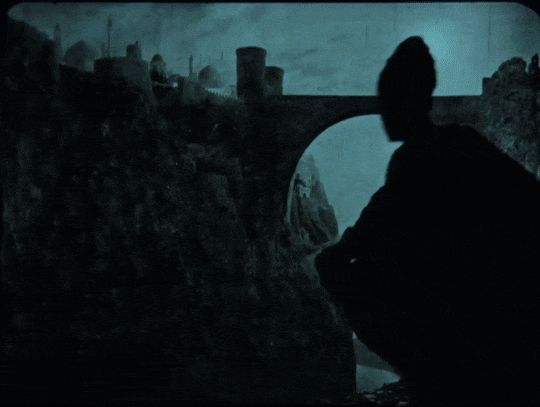
see all gifs here
Earle, knowing that traditional stills could not be taken while filming, brought in Edward S. Curtis. Curtis developed techniques in still photography to replicate the look of the photographic effects used for the film. So, even though the film hasn’t survived, we have some pretty great looking representations of some of the 1000s of missing feet of the film.

Nearly a year before Curtis joined the crew, Earle began collaboration with composer Charles Wakefield Cadman. In another bold creative move, Cadman and Earle worked closely before principal photography began so that the score could inform the construction and rhythm of the film and vice versa.
By the end of 1921 the film was complete. After roughly 9 months and the creation of over 500 paintings, The Rubaiyat was almost ready to meet its public. However, the investors in The Rubaiyat, Inc., the corporation formed by Earle to produce the film, objected to the ample reference to wine drinking (a comical objection if you’ve read the poems) and wanted the roles of the young lovers (played by as yet unknown Ramon Novarro and Kathleen Key) to be expanded. The dispute with Earle became so heated that the financiers absconded with the bulk of the film to New York. Earle filed suit against them in December to prevent them from screening their butchered and incomplete cut. Cadman supported Earle by withholding the use of his score for the film.
Later, Eastern Film Corp. brokered a settlement between the two parties, where Earle would get final cut of the film and Eastern would handle its release. Earle and Eastern agreed to change the title from The Rubaiyat of Omar Khayyam to simply Omar. Omar had its first official preview in New York City. It was tentatively announced that the film would have a wide release in the autumn.
However, before that autumn, director Norman Dawn launched a dubious patent-infringement suit against Earle and others. Dawn claimed that he owned the sole right to use multiple exposures, glass painting for single exposure, and other techniques that involved combining live action with paintings. All the cited techniques had been widespread in the film industry for a decade already and eventually and expectedly Dawn lost the suit. Despite Earle’s victory, the suit effectively put the kibosh on Omar’s release in the US.
Earle moved on to other projects that didn’t come to fruition, like a Theda Bara film and a frankly amazing sounding collaboration with Cadman to craft a silent-film opera of Faust. Omar did finally get a release, albeit only in Australia. Australian news outlets praised the film as highly as those few lucky attendees of the American preview screenings did. The narrative was described as not especially original, but that it was good enough in view of the film’s artistry and its imaginative “visual phenomena” and the precision of its technical achievement.
One reviewer for The Register, Adelaide, SA, wrote:
“It seems almost an impossibility to make a connected story out of the short verse of the Persian of old, yet the producer of this classic of the screen… has succeeded in providing an entertainment that would scarcely have been considered possible. From first to last the story grips with its very dramatic intensity.”
While Omar’s American release was still in limbo, “Ramon Samaniegos” made a huge impression in Rex Ingram’s Prisoner of Zenda (1922, extant) and Scaramouche (1923, extant) and took on a new name: Ramon Novarro. Excitement was mounting for Novarro’s next big role as the lead in the epic Ben-Hur (1925, extant) and the Omar project was re-vivified.
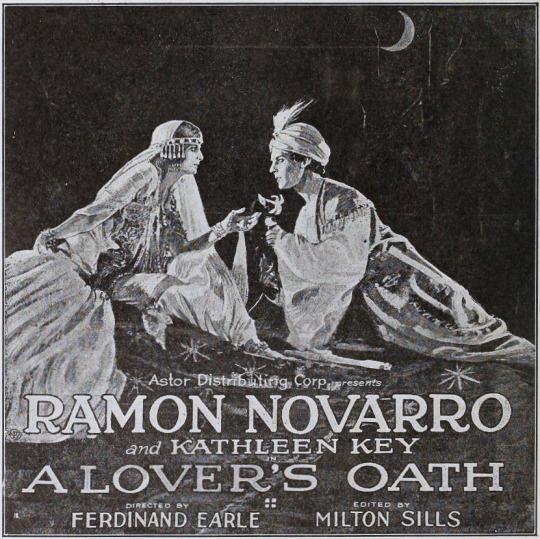
A new company, Astor Distribution Corp., was formed and purchased the distribution rights to Omar. Astor hired actor (note, not an editor) Milton Sills to re-cut the film to make Novarro and Key more prominent. The company also re-wrote the intertitles, reduced the films runtime by more than ten minutes, and renamed the film A Lover’s Oath. Earle had moved on by this point, vowing to never direct again. In fact, Earle was indirectly working with Novarro and Key again at the time, as an art director on Ben-Hur!
Despite Omar’s seemingly auspicious start in 1920, it was only released in the US on the states rights market as a cash-in on the success of one of its actors in a re-cut form five years later.
That said, A Lover’s Oath still received some good reviews from those who did manage to see it. Most of the negative criticism went to the story, intertitles, and Sills’ editing.
What kind of legacy could/should Omar have had? I’m obviously limited in my speculation by the fact that the film is lost, but there are a few key facts about the film’s production, release, and timing to consider.
The production budget was stated to be $174,735. That is equivalent to $3,246,994.83 in 2024 dollars. That is a lot of money, but since the production was years long and Omar was a period film set in a remote locale and features fantastical special effects sequences, it’s a modest budget. For contemporary perspective, Robin Hood (1922, extant) cost just under a million dollars to produce and Thief of Bagdad (1924, extant) cost over a million. For a film similarly steeped in spectacle to have nearly 1/10th of the budget is really very noteworthy. And, perhaps if the film had ever had a proper release in the US—in Earle’s intended form (that is to say, not the Sills cut)—Omar may have made as big of a splash as other epics.
It’s worth noting here however that there are a number of instances in contemporary trade and fan magazines where journalists off-handedly make this filmmaking experiment about undermining union workers. Essentially implying that that value of Earle’s method would be to continue production when unionized workers were striking. I’m sure that that would absolutely be a primary thought for studio heads, but it certainly wasn’t Earle’s motivation. Often when Earle talks about the method, he focuses on being able to film things that were previously impossible or impracticable to film. Driving down filming costs from Earle’s perspective was more about highlighting the artistry of his own specialty in lieu of other, more demanding and time-consuming approaches, like location shooting.
This divide between artists and studio decision makers is still at issue in the American film and television industry. Studio heads with billion dollar salaries constantly try to subvert unions of skilled professionals by pursuing (as yet) non-unionized labor. The technical developments of the past century have made Earle’s approach easier to implement. However, just because you don’t have to do quite as much math, or time an actor’s movements to a metronome, does not mean that filming a combination of painted/animated and live-action elements does not involve skilled labor.
VFX artists and animators are underappreciated and underpaid. In every new movie or TV show you watch there’s scads of VFX work done even in films/shows that have mundane, realistic settings. So, if you love a film or TV show, take the effort to appreciate the work of the humans who made it, even if their work was so good you didn’t notice it was done. And, if you’ve somehow read this far, and are so out of the loop about modern filmmaking, Disney’s “live-action” remakes are animated films, but they’ve just finagled ways to circumvent unions and low-key delegitimize the skilled labor of VFX artists and animators in the eyes of the viewing public. Don’t fall for it.
VFX workers in North America have a union under IATSE, but it’s still developing as a union and Marvel & Disney workers only voted to unionize in the autumn of 2023. The Animation Guild (TAG), also under the IATSE umbrella, has a longer history, but it’s been growing rapidly in the past year. A strike might be upcoming this year for TAG, so keep an eye out and remember to support striking workers and don’t cross picket lines, be they physical or digital!
Speaking of artistry over cost-cutting, I began this post with a mention that in the early 1920s, the American film industry was developing an inferiority complex in regard to its own artistry. This was in comparison to the European industries, Germany’s being the largest at the time. It’s frustrating to look back at this period and see acceptance of the opinion that American filmmakers weren’t bringing art to film. While yes, the emergent studio system was highly capitalistic and commercial, that does not mean the American industry was devoid of home-grown artists.
United Artists was formed in 1919 by Douglas Fairbanks, Charlie Chaplin, Mary Pickford, and D.W. Griffith precisely because studios were holding them back from investing in their art—within the same year that Earle began his Omar project. While salaries and unforgiving production schedules were also paramount concerns in the filmmakers going independent, a primary impetus was that production/distribution heads exhibited too much control over what the artists were trying to create.
Fairbanks was quickly expanding his repertoire in a more classical and fantastic direction. Cecil B. DeMille made his first in a long and very successful string of ancient epics. And the foreign-born children of the American film industry, Charlie Chaplin, Rex Ingram, and Nazimova, were poppin’ off! Chaplin was redefining comedic filmmaking. Ingram was redefining epics. Nazimova independently produced what is often regarded as America’s first art film, Salome (1923, extant), a film designed by Natacha Rambova, who was *gasp* American. Earle and his brother, William, had ambitious artistic visions of what could be done in the American industry and they also had to self-produce to get their work done.
Meanwhile, studio heads, instead of investing in the artists they already had contracts with, tried to poach talent from Europe with mixed success (in this period, see: Ernst Lubitsch, F.W. Murnau, Benjamin Christensen, Mauritz Stiller, Victor Sjöström, and so on). I’m in no way saying it was the wrong call to sign these artists, but all of these filmmakers, even if they found success in America, had stories of being hired to inject the style and artistry that they developed in Europe into American cinema, and then had their plans shot down or cut down to a shadow of their creative vision. Even Stiller, who tragically died before he had the opportunity to establish himself in the US, faced this on his first American film, The Temptress (1926, extant), on which he was replaced. Essentially, the studio heads’ actions were all hot air and spite for the filmmakers who’d gone independent.

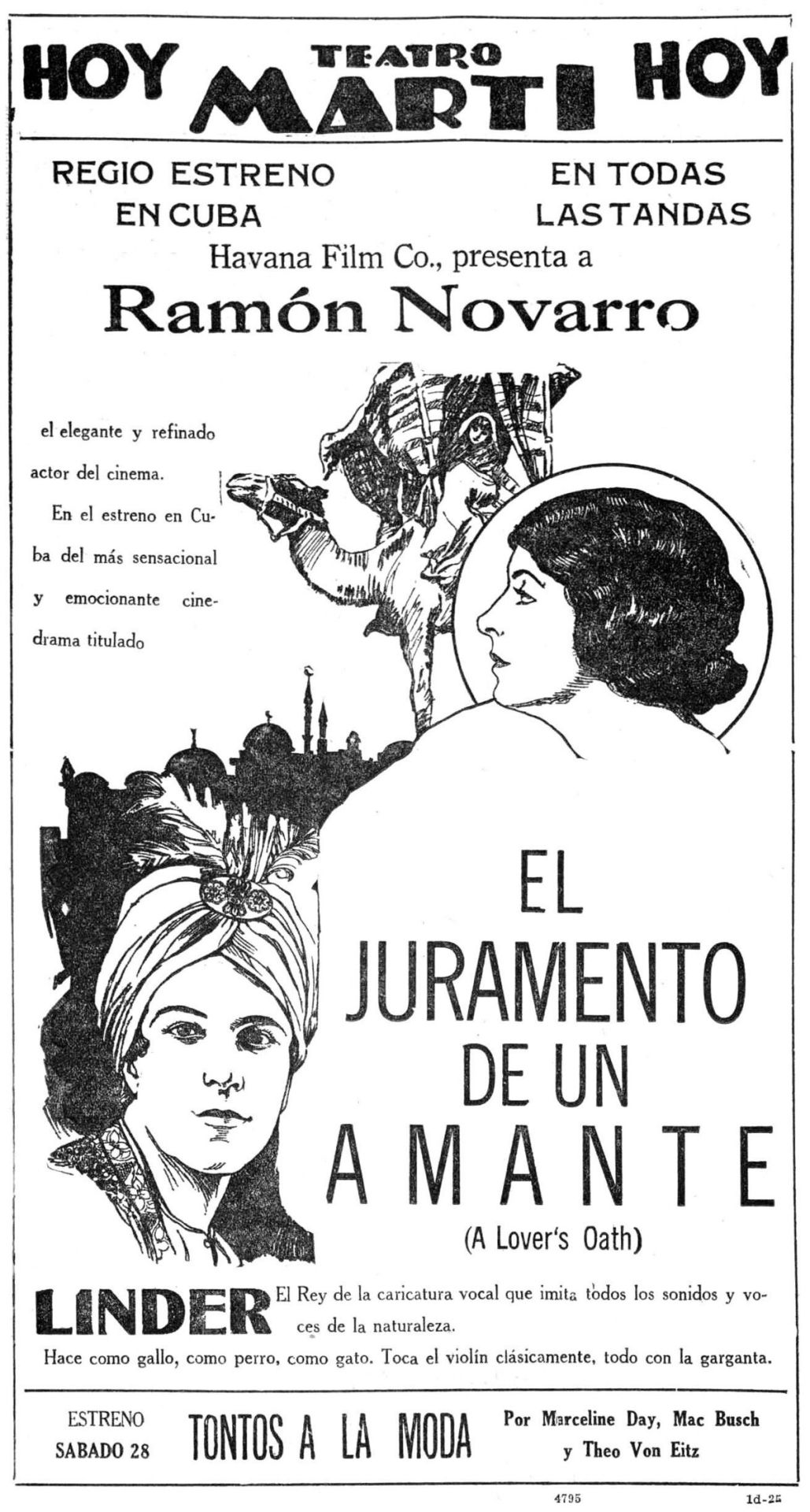
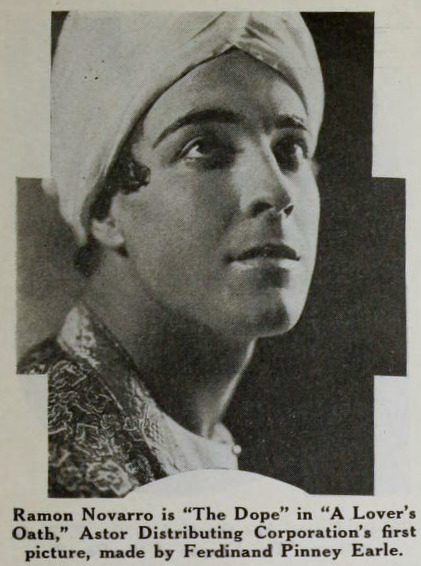
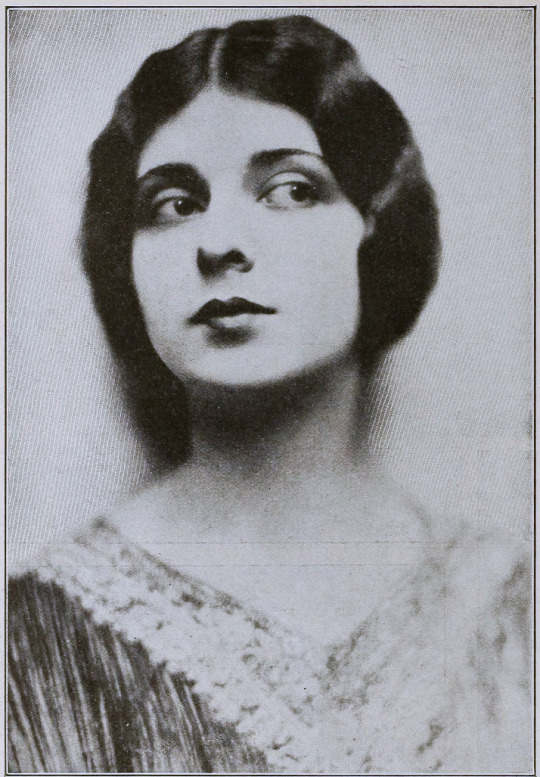
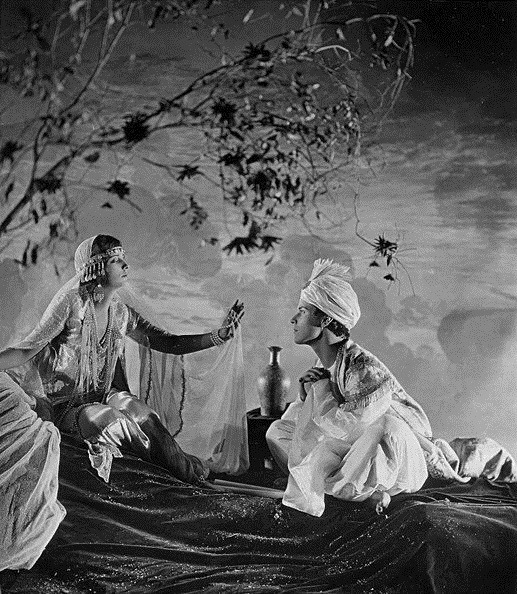
Finally I would like to highlight Ferdinand Earle’s statement to the industry, which he penned for from Camera in 14 January 1922, when his financial backers kidnapped his film to re-edit it on their terms:
MAGNA CHARTA
Until screen authors and producers obtain a charter specifying and guaranteeing their privileges and rights, the great slaughter of unprotected motion picture dramas will go merrily on.
Some of us who are half artists and half fighters and who are ready to expend ninety per cent of our energy in order to win the freedom to devote the remaining ten per cent to creative work on the screen, manage to bring to birth a piteous, half-starved art progeny.
The creative artist today labors without the stimulus of a public eager for his product, labors without the artistic momentum that fires the artist’s imagination and spurs his efforts as in any great art era.
Nowadays the taint of commercialism infects the seven arts, and the art pioneer meets with constant petty worries and handicaps.
Only once in a blue moon, in this matter-of-fact, dollar-wise age can the believer in better pictures hope to participate in a truely [sic] artistic treat.
In the seven years I have devoted to the screen, I have witnessed many splendid photodramas ruined by intruding upstarts and stubborn imbeciles. And I determined not to launch the production of my Opus No. 1 until I had adequately protected myself against all the usual evils of the way, especially as I was to make an entirely new type of picture.
In order that my film verison [sic] of the Rubaiyat of Omar Khayyam might be produced under ideal conditions and safeguarded from intolerable interferences and outside worries, I entered into a contract with the Rubaiyat, Inc., that made me not only president of the corporation and on the board of directors, but which set forth that I was to be author, production manager, director, cutter and film editor as well as art director, and that no charge could be made against the production without my written consent, and that my word was to be final on all matters of production. The late George Loane Tucker helped my attorney word the contract, which read like a splendid document.
Alas, I am now told that only by keeping title to a production until it is declared by yourself to be completed is it safe for a scenario writer, an actor or a director, who is supposedly making his own productions, to contract with a corporation; otherwise he is merely the servant of that corporation, subject at any moment to discharge, with the dubious redress of a suit for damages that can with difficulty be estimated and proven.
Can there be any hope of better pictures as long as contracts and copyrights are no protection against financial brigands and bullies?
We have scarcely emerged from barbarism, for contracts, solemnly drawn up between human beings, in which the purposes are set forth in the King’s plainest English, serve only as hurdles over which justice-mocking financiers and their nimble attorneys travel with impunity, riding rough shod over the author or artist who cannot support a legal army to defend his rights. The phrase is passed about that no contract is invioliable [sic]—and yet we think we have reached a state of civilization!
The suit begun by my attorneys in the federal courts to prevent the present hashed and incomplete version of my story from being released and exhibited, may be of interest to screen writers. For the whole struggle revolves not in the slightest degree around the sanctity of the contract, but centers around the federal copyright of my story which I never transferred in writing otherwise, and which is being brazenly ignored.
Imagine my production without pictorial titles: and imagine “The Rubaiyat” with a spoken title as follows, “That bird is getting to talk too much!”—beside some of the immortal quatrains of Fitzgerald!
One weapon, fortunately, remains for the militant art creator, when all is gone save his dignity and his sense of humor; and that is the rapier blade of ridicule, that can send lumbering to his retreat the most brutal and elephant-hided lord of finance.
How edifying—the tableau of the man of millions playing legal pranks upon men such as Charles Wakefield Cadman, Edward S. Curtis and myself and others who were associated in the bloody venture of picturizing the Rubaiyat! It has been gratifying to find the press of the whole country ready to champion the artist’s cause.
When the artist forges his plowshare into a sword, so to speak, he does not always put up a mean fight.
What publisher would dare to rewrite a sonnet of John Keats or alter one chord of a Chopin ballade?
Creative art of a high order will become possible on the screen only when the rights of established, independent screen producers, such as Rex Ingram and Maurice Tourneur, are no longer interferred with and their work no longer mutilated or changed or added to by vandal hands. And art dramas, conceived and executed by masters of screen craft, cannot be turned out like sausages made by factory hands. A flavor of individuality and distinction of style cannot be preserved in machine-made melodramas—a drama that is passed from hand to hand and concocted by patchworkers and tinkerers.
A thousand times no! For it will always be cousin to the sausage, and be like all other—sausages.
The scenes of a master’s drama may have a subtle pictorial continuity and a power of suggestion quite like a melody that is lost when just one note is changed. And the public is the only test of what is eternally true or false. What right have two or three people to deprive millions of art lovers of enjoying an artist’s creation as it emerged from his workshop?
“The Rubaiyat” was my first picture and produced in spite of continual and infernal interferences. It has taught me several sad lessons, which I have endeavored in the above paragraphs to pass on to some of my fellow sufferers. It is the hope that I am fighting, to a certain extent, their battle that has given me the courage to continue, and that has prompted me to write this article. May such hubbubs eventually teach or inforce a decent regard for the rights of authors and directors and tend to make the existence of screen artisans more secure and soothing to the nerves.
FERDINAND EARLE.
---
☕Appreciate my work? Buy me a coffee! ☕
Transcribed Sources & Annotations over on the WMM Blog!
See the Timeline for Ferdinand P. Earle's Rubaiyat Adaptation
#1920s#1923#1925#omar khayyam#ferdinand pinney earle#ramon novarro#independent film#american film#silent cinema#silent era#silent film#classic cinema#classic movies#classic film#film history#history#Charles Wakefield Cadman#cinematography#The Rubaiyat#cinema#film#lost film
48 notes
·
View notes
Photo







Samara Weaving poses at the Babylon premiere at State Theatre on January 16, 2023 in Sydney, Australia.
#samara weaving#babylon#samaraweavingedit#dailywomen#flawlessbeautyqueens#femaledaily#thequeensofbeauty#femalestunning#glamoroussource#sweavingedit#babylon 2022
273 notes
·
View notes
Text
BD - winners where are they now (incomplete)
I think someone requested this somewhere
Most females and recent males because there are just too many to do rn
At companies:
Miriam Gittens (s2013): Gibney Company
Alyssa Allen (s2014): Ballets Jazz Montreal
Brianne Sellars (s2014): Dallas Black Dance Theatre
Ashley Green (s2015): Alvin Ailey American dance Theater
Payton Johnson (j2012, t2015, s2017): L.A. Dance Project
Vivian Ruiz (s2019): Ballet BC
Kelis Robinson (t2018, s2020): The Batsheva Dance Company; The Juilliard School
Kiarra Waidelich (m2016, j2018, t2020): Royal Flux Company
Quinn Starner (t2017): New York City Ballet Corps de Ballet
Emma Sutherland (j2014, t2016): MashUp Contemporary Dance Co.
Sarah Pippin (t2011): Ballet BC
Timmy Blankenship (s2017): Sydney Dance Company; choreographer
Brady Farrar (m2014, j2017, t2021): ABT Junior Company
Easton Magliarditi (t2020): Royal Flux Company
Graham Feeny (t2015): Artistic associate at Gibney Company
Logan Hernandez (t2015): Göteborgs Operans Danskompani
Zenon Zubyk (t2013): Nederlands Dans Theater
Jonathan Wade (j2011, s2016): Rambert Dance Company
Wyeth Walker (s2017): Rubberband Dance Company
Faculty/teacher/choreography:
Lucy Vallely (t2015, s2018): Broadway Dance Center, freelance choreographer
Jayci Kalb ( j2011, t2014, s2016): The Dance Centre; Radio City Clara 2010
Taylor Sieve (s2016): Jump Dance Convention
Jenna Johnson (s2012): DWTS pro, 24 Seven Dance Convention
Jazzmin James (t2012, s2015): faculty several intensives
Jaycee Wilkins (j2015): Club Dance Studio
Sophia Lucia (j2014): Dancelab OC
Brynn Rumfallo (m2014): Strive Dance Workshop (own project)
Talia Seitel (m2012): Project 21 (part-time)
Lex Ishimoto (t2014, s2016): Jump Dance Convention
at University/college:
Ellie Wagner (s2019): Ohio State University Dance Team
Ella Horan (s2021): USC Kaufman
Kayla Mak (m2014, s2021): The Juilliard School; Radio City Clara 2014, 2015
Brianna Keingatti (s2022): The Juilliard School
Julia Lowe (s2023): USC Kaufman
Ava Wagner (j2018): University of Minnesota Dance Team
Avery Gay (m2015, j2017): University of Arizona School of Dance
Leara Stanley (m2011): Duke University
Sam Fine (s2023): USC Kaufman; Young Arts 2022
Seth Gibson: The Juilliard School
Alex Shulman (s2022): New York University Tisch Dance
Joziah German (m2014, t2018, s2020): The Juilliard School
Joey Gertin (t2018): The Juilliard School
Professional dancer/choreographer:
Simrin Player (t2014, s2017): The Voice, Missy Elliot, Justin Bieber, RBD
Jaxon Williard (s2021): Rihanna, Madonna, Lil Nas X
D'Angelo Castro (j2012, t2016, s2019): DWTS troupe
Findlay Mcconnell (t2017, s2019): Tate McRace
Christian Smith (s2018): Tate McRae, NBC's Saved by the Bell
Keanu Uchida (s2014): Dancer the Musical; also a big advocate for protecting dancers and calling out inappropriate behaviour
Eric Schloesser (s2014): Lady Gaga, Katy Perry, Dua Lipa, Billie Eilish, J Balvin; choreographer, creative director, designer; Dana Foglia Dance Company
Other/a combo of things:
Bianca Melchior (s2011): actor, dancer, singer; Nick Jonas, Alessia Cara, own music; faculty at On The Floor dance competition
Tate McRae (m2013, j2015, t2018): singer/songwriter
Bostyn Brown (j2016, t2019): Professional assistant at DanceOne
Megan Goldstein (t2017); dancer, photographer
Christina Ricucci (t2013): actor, musician, dancer
Bella Klassen (j2017): The Space, vlogger
Kalani Hilliker (j2013): influencer, teaching at several places (Danceplex, MBA)
Elliana Walmsley (m2018): influencer, DWTS Junior, Radio City Clara 2019
Diana Pombo (m2016): singer/songwriter, dancer, actor; Young Arts voice 2023+2024
Morgan Higgins (t2016, s2018): dancer, aerialist
Zelig Williams (s2013):dancer/actor: MJ the Musical, Hamilton
Daniel Gaymon (s2011): dancer/actor; Broadway (Cats, The Lion King); Hamilton national tour, La La Land
Ricky Ubeda (t2011, s2012): choreographer, actor; Steven Spielberg's West Side Story
Michael Hall (s2015): Saturday Night Fever the Musical, tv dancer in Cairo, Egypt; teacher
Julian Elia (t2014): Steven Spielberg's Westside Story, working on the development of a new Broadway musical
Sage Rosen (t2016): influencer; DWTS Junior
Ryan Maw (j2015, t2017): choreographer, dancer, actor: High School Musical: The Musical - The Series
Holden Maples (j2016, t2019): dancer, teacher, choreographer
Competing/not graduated honorable mentions:
Cameron Voorhees (m2018, j2021, t2023): Evolve Dance Complex; starting career as a teacher/choreographer
Crystal Huang (m2019, j2021, t2023): The Rock Center for Dance, Bayer Ballet Academy; Prix De Lausanne 2024, Young Arts 2024, Radio City Clara 2021
Hailey Bills (m2017, t2022): Center Stage Performing Arts Studio, DWTS Junior
Brightyn Brems (m2017): DWTS Junior
Avery Hall (t2022): Danceology; Young Arts 2023
Savannah Kristich (t2021): The Rock Center For Dance; Twyla Now
Savannah Manzel (m2020): Larkin Dance Studio, Radio City Clara 2023
Kya Massimino (m2021): Radio City Clara 2023
Ian Stegeman (m2019, j2021, t2023): Woodbury Dance Center, Young Arts 2024
49 notes
·
View notes
Text
NEWS: The Lord of the Rings: A Musical Tale is heading to Australia!
The production, which originated at the Watermill Theatre in the UK in 2023 and is currently playing in Chicago, IL, USA until September, will play a limited season at Auckland's The Civic in Aotearoa from 5 November 2024 before transferring to the State Theatre in Sydney, Australia from 7 January 2025.
Auditions for a new, all-Australian cast of actor-musicians are currently underway.
Tickets on sale in early September - sign up for priority access here!
Teaser:
youtube
#lotr musical#lord of the rings musical#news#state theatre sydney#trailer#video#australian tour#gwb tour
57 notes
·
View notes
Text
Ticket offers by show date
OCT 06 Seattle, WA / Moore Theatre
OCT 07 Seattle, WA / Moore Theatre
OCT 08 Portland, OR / Arlene Schnitzer Auditorium
OCT 09 Vancouver, BC / Orpheum Theatre
OCT 11 Oakland, CA / Paramount Theatre
OCT 13 Phoenix, AZ / Celebrity Theatre
OCT 17 San Diego, CA / Civic Theatre
OCT 18 Los Angeles, CA / Peacock Theater
OCT 20 Salt Lake City, UT / The Union
OCT 21 Denver, CO / Ellie Caulkins Opera House
OCT 23 Kansas City, MO / The Midland
OCT 24 Grand Prairie, TX / Texas Trust Theatre
OCT 25 Austin, TX / Bass Concert Hall
OCT 27 St. Louis, MO / The Factory
OCT 28 Detroit, MI / Masonic Temple
OCT 29 Akron, OH / Civic Theatre
OCT 30 Indianapolis, IN / Clowes Memorial Hall
NOV 01 Milwaukee, WI / Riverside Theater
NOV 02 Minneapolis, MN / State Theatre
NOV 03 Chicago, IL / Chicago Theatre
NOV 05 Toronto, ON / Massey Hall
NOV 08 Philadelphia, PA / Miller Theater
NOV 10 New York, NY / Kings Theatre
NOV 11 Tysons, VA / Capital One Hall
NOV 12 Tysons, VA / Capital One Hall
NOV 14 Atlanta, GA / Cobb Energy PAC
NOV 16 Tampa, FL / Tampa Theatre
NOV 17 Orlando, FL / Hard Rock Live
NOV 18 Fort Lauderdale, FL / The Parker
NOV 20 Durham, NC / DPAC
NOV 21 Nashville, TN / Andrew Jackson Hall
NOV 24 Boston, MA / Wang Theatre
NOV 25 Reading, PA / Santander PAC
NOV 26 Red Bank, NJ / Count Basie
DEC 07 Brisbane, AUSTRALIA / Convention Centre
DEC 09 Sydney, AUSTRALIA / State Theatre
DEC 10 Sydney, AUSTRALIA / State Theatre
DEC 12 Perth, AUSTRALIA / Riverside Theatre
DEC 15 Melbourne, AUSTRALIA / Plenary
DEC 16 Adelaide, AUSTRALIA / AEC Theatre
DEC 19 Auckland, NEW ZEALAND / KTK Theatre
JAN 13 Birmingham, UK / Symphony Hall
JAN 15 Cardiff, UK / New Theatre
JAN 16 Cardiff, UK / New Theatre
JAN 17 Plymouth, UK / Pavilions
JAN 18 Brighton, UK / Brighton Dome
JAN 19 Brighton, UK / Brighton Dome
JAN 22 Birmingham, UK / Symphony Hall
JAN 24 London, UK / London Palladium
JAN 25 London, UK / London Palladium
JAN 26 London, UK / London Palladium (Matinee)
JAN 26 London, UK / London Palladium
JAN 28 Newcastle, UK / Tyne Theatre
JAN 29 Manchester, UK / O2 Apollo
JAN 30 Manchester, UK / O2 Apollo
JAN 31 Dublin, IRELAND / CCD
FEB 02 Belfast, UK / Waterfront Hall
FEB 03 Glasgow, UK / King's Theatre
FEB 04 Glasgow, UK / Kings Theatre
FEB 06 Amsterdam, NETHERLANDS / AFAS Live
FEB 07 Reykjavík, ICELAND / Háskólabíó
7 notes
·
View notes
Text

Mike Faist attends the Australian premiere of "Challengers" at the State Theatre on March 26, 2024 in Sydney, Australia.
#mike faist#flawlessgentlemen#flawlesscelebs#dailycelebs#dailymenedit#dailymencelebs#mancandykings#glamoroussource#challengers#mikefaistedit
64 notes
·
View notes
Text
Haha -- at least her boyfriend has a sense of humor lol 🤭
12 notes
·
View notes
Text

5/5/24 Nick Cave Sydney State Theatre
12 notes
·
View notes